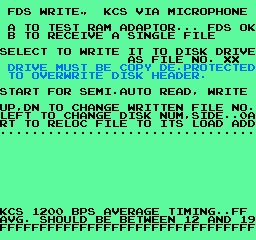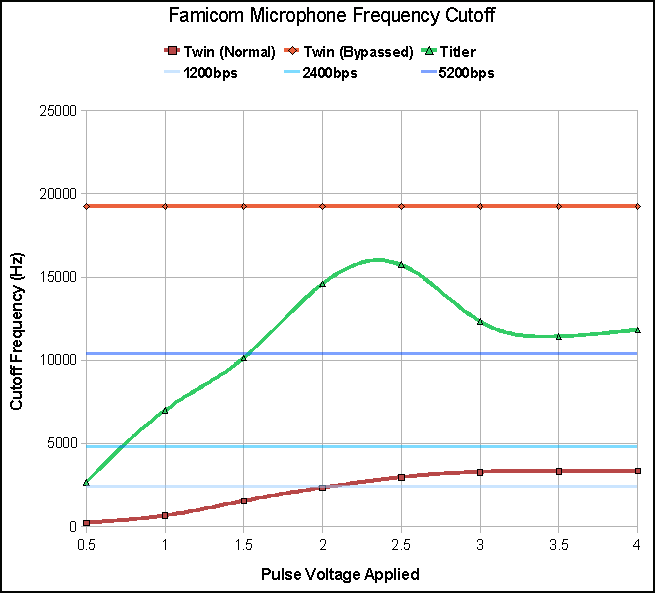Hi, everyone. The NES programming bug hit me again (or was it a wave of FDS nostalgia that did it?) and so I wanted to find a way to upload .FDS images and save them to disk using my program, TapeDump (version 1.0 here). I was wondering, continuing the "no extra hardware needed" idea, whether KCS audio files could be sent TO the NES, or Famicom, via the microphone, or something.
Anyway, I didn't try to get KCS decoding going on the Famicom just yet (anybody has any advice with tape decoding, let me know) because I thought the simpler first step would be to get general (fast) data uploading going on the Famicom with a dedicated cable. Last summer I in fact did make a special cable for my C-64 DTV using the schematic included with DTVTrans, the software that uploads data to the C-64 via the PC's parallel port at a good rate.
So here are the initial results of my experiment:
Here's how I connected the DTVTrans cable to the Famicom expansion port:
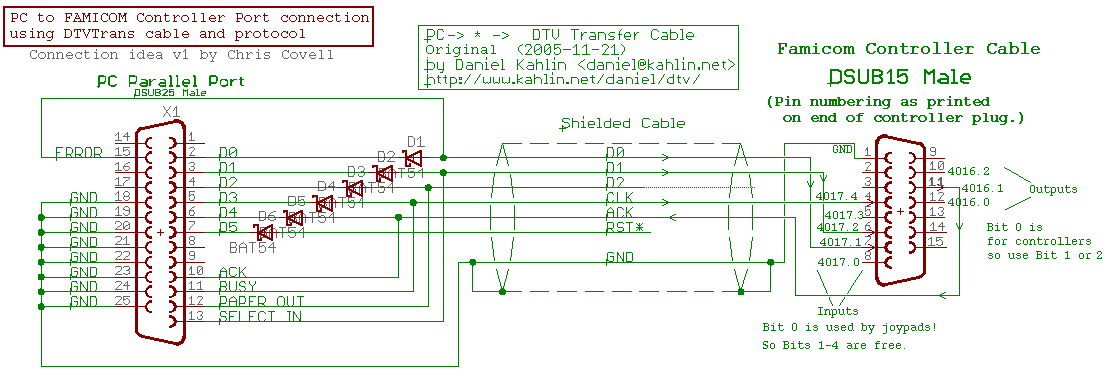
I adapted this cable to the Famicom's expansion port, choosing wires that wouldn't conflict with the existing connected joypads, and got the wiring all right and software polling of the data lines working. Using the DTVTrans software on the PC, I can upload files to the Famicom at about 4.6Kbytes/sec.
I then got down to studying how to write to FDS disks, and eventually, using a disk drive that HAS NO COPY-PROTECTION CIRCUITRY, got my software to write full FDS disk images from the PC! Since my current PC can't run FDSLoader at all, this disk re-writing via parallel port is the next best thing.
A quick whipped-together ZIP file: http://www.chrismcovell.com/data/TapeDu ... Writer.zip
(my in-progress version skips the usual TapeDump title screen and goes directly to the FDS Writer code)
Pic of it writing:

Loading of FDS files straight to the RAM adaptor for soft booting works well too, though some files can't be loaded properly, and several games read the FDS disk themselves right after booting, but it's a good way to load your own software onto the FDS RAM unit for quick testing.
Pic of RAM upload:
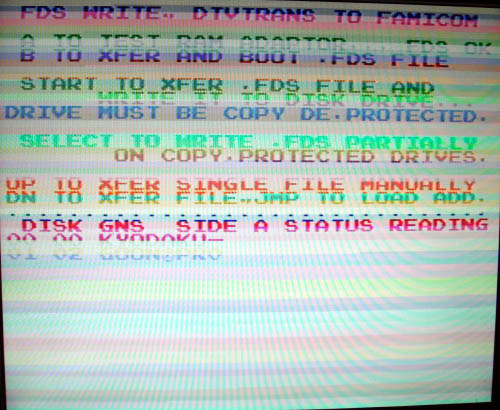
---
Okay, so I'll keep working on this program since it still needs polishing and stuff. Does anybody have any comments about the cable and connection method?
The $4016/$4017 bit assignments are not set in stone for now, but there are some limitations. I can't use the same $4016/7 bit assignments for the Famicom and the NES, because the NES has a few too many of those bits going to its expansion port, not the joystick port. And the bits that ARE usable on NES Joy 2 can't be used on the Famicom without having to disconnect the usually hard-wired Joystick 2 on the Famicom. That's why I chose other available bits on the Fami expansion connector.
If anybody makes a cable to try this out on their Famicoms, let me know if it works. The DTVTrans cable calls for Schottky-barrier diodes but the requirement may not be that strict. I've included a "PortTest.NES" program for debugging and verifying correct cable operation. (Remember that, as I discovered to my surprise, lines being sent to the Famicom appear logically inverted, because the Fami uses pull-up resistors, or something like that...)
Port tester:
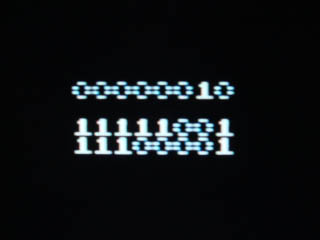
Anyway, I didn't try to get KCS decoding going on the Famicom just yet (anybody has any advice with tape decoding, let me know) because I thought the simpler first step would be to get general (fast) data uploading going on the Famicom with a dedicated cable. Last summer I in fact did make a special cable for my C-64 DTV using the schematic included with DTVTrans, the software that uploads data to the C-64 via the PC's parallel port at a good rate.
So here are the initial results of my experiment:
Here's how I connected the DTVTrans cable to the Famicom expansion port:

I adapted this cable to the Famicom's expansion port, choosing wires that wouldn't conflict with the existing connected joypads, and got the wiring all right and software polling of the data lines working. Using the DTVTrans software on the PC, I can upload files to the Famicom at about 4.6Kbytes/sec.
I then got down to studying how to write to FDS disks, and eventually, using a disk drive that HAS NO COPY-PROTECTION CIRCUITRY, got my software to write full FDS disk images from the PC! Since my current PC can't run FDSLoader at all, this disk re-writing via parallel port is the next best thing.
A quick whipped-together ZIP file: http://www.chrismcovell.com/data/TapeDu ... Writer.zip
(my in-progress version skips the usual TapeDump title screen and goes directly to the FDS Writer code)
Pic of it writing:

Loading of FDS files straight to the RAM adaptor for soft booting works well too, though some files can't be loaded properly, and several games read the FDS disk themselves right after booting, but it's a good way to load your own software onto the FDS RAM unit for quick testing.
Pic of RAM upload:

---
Okay, so I'll keep working on this program since it still needs polishing and stuff. Does anybody have any comments about the cable and connection method?
The $4016/$4017 bit assignments are not set in stone for now, but there are some limitations. I can't use the same $4016/7 bit assignments for the Famicom and the NES, because the NES has a few too many of those bits going to its expansion port, not the joystick port. And the bits that ARE usable on NES Joy 2 can't be used on the Famicom without having to disconnect the usually hard-wired Joystick 2 on the Famicom. That's why I chose other available bits on the Fami expansion connector.
If anybody makes a cable to try this out on their Famicoms, let me know if it works. The DTVTrans cable calls for Schottky-barrier diodes but the requirement may not be that strict. I've included a "PortTest.NES" program for debugging and verifying correct cable operation. (Remember that, as I discovered to my surprise, lines being sent to the Famicom appear logically inverted, because the Fami uses pull-up resistors, or something like that...)
Port tester:


